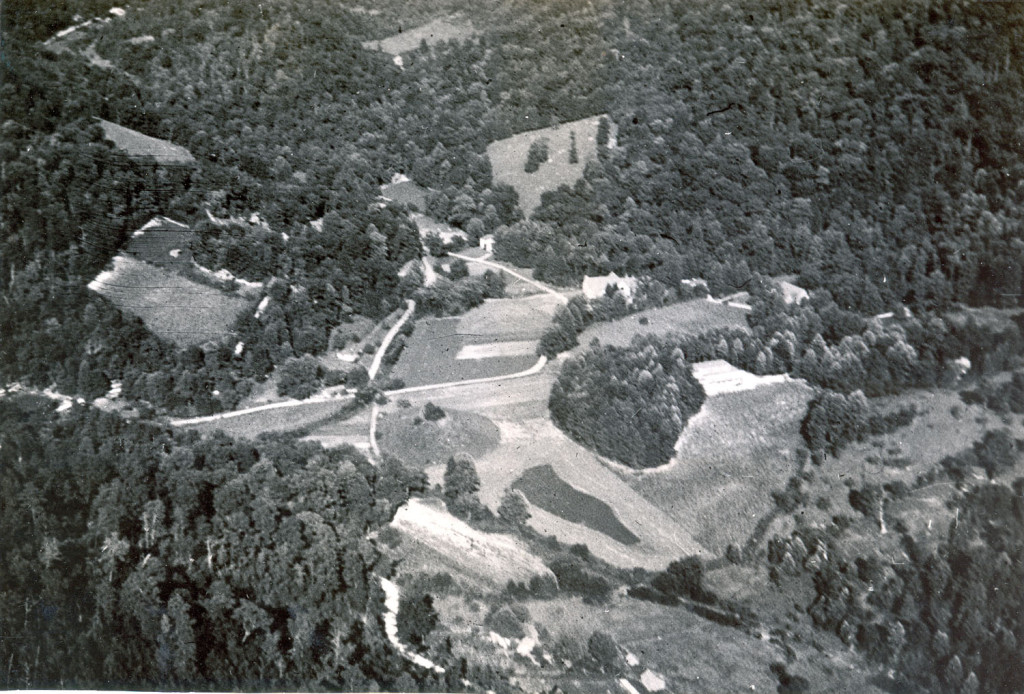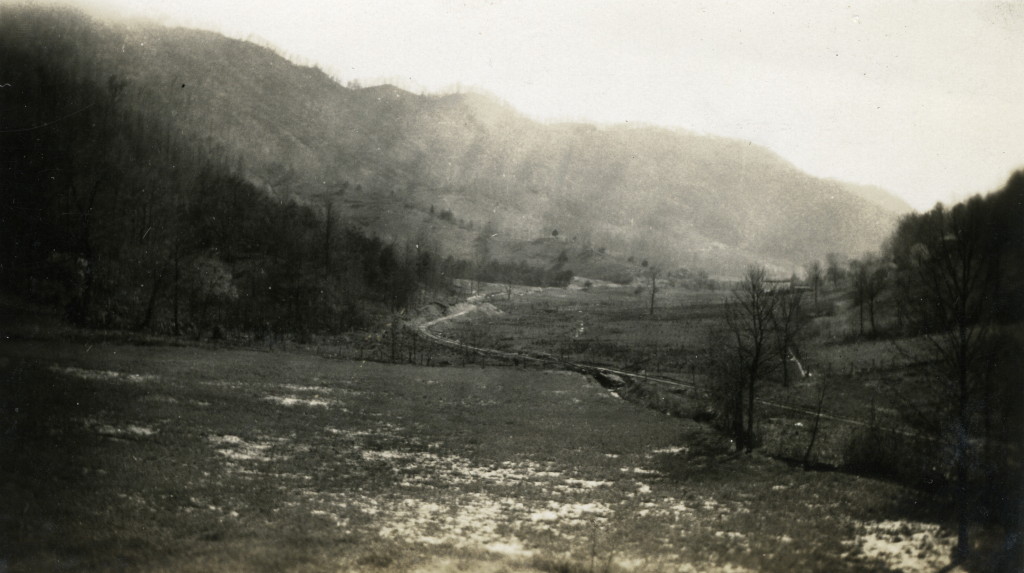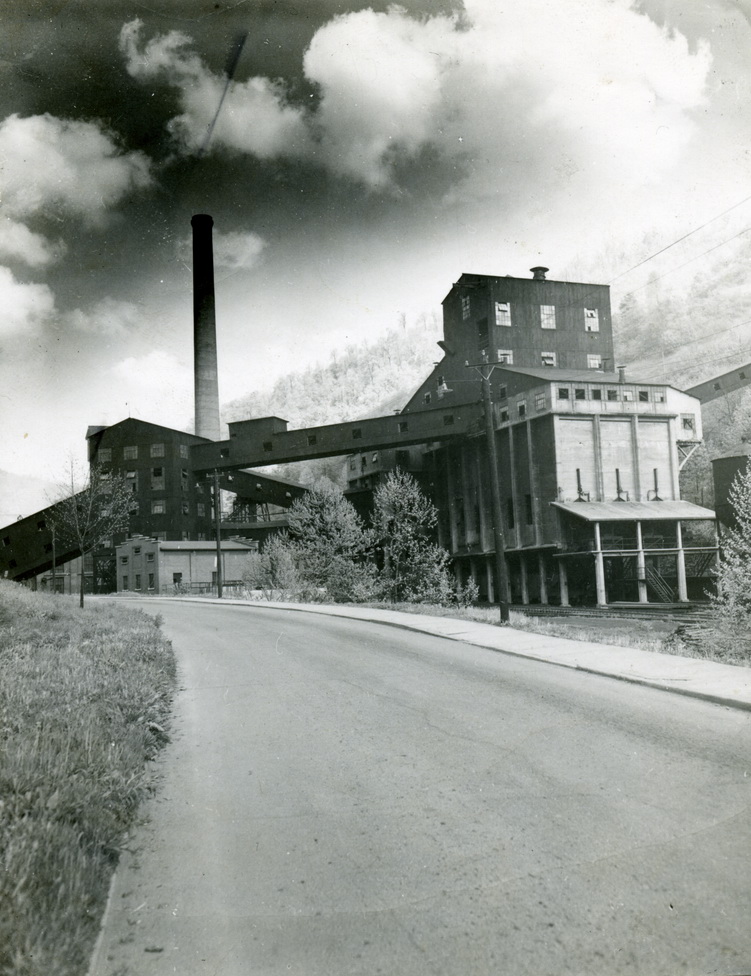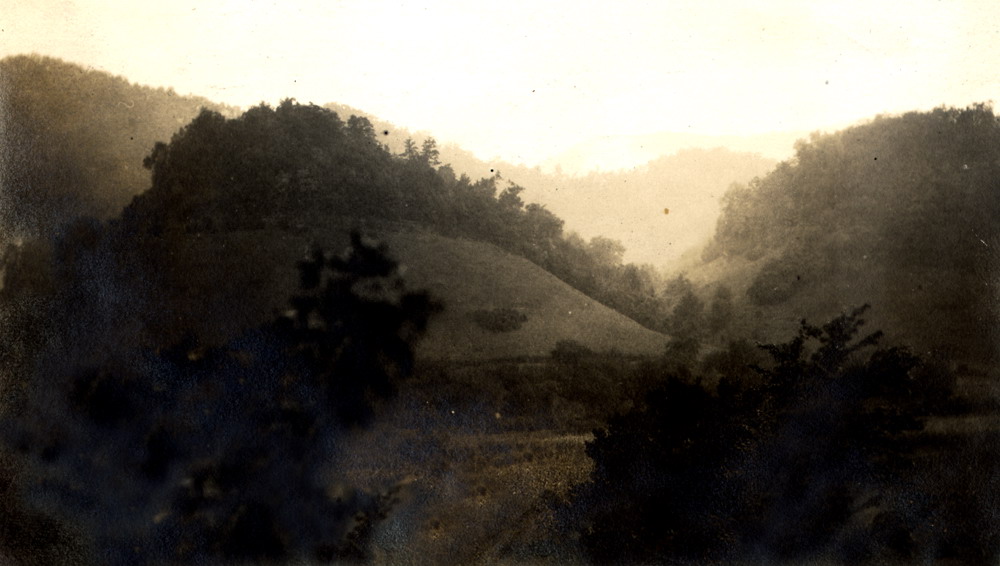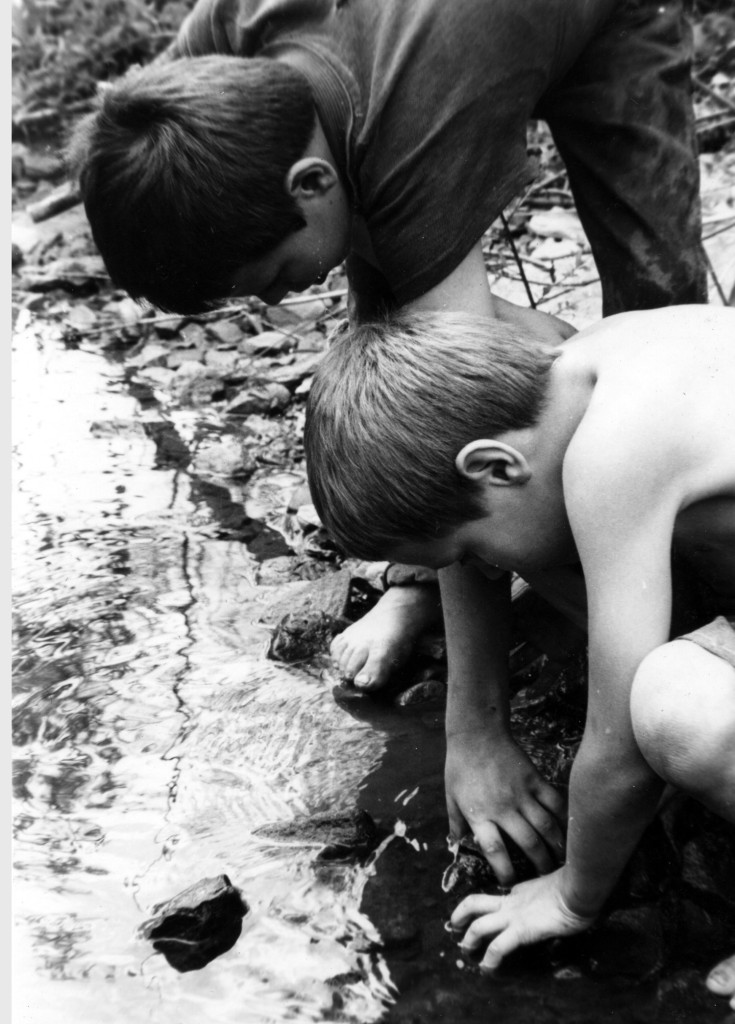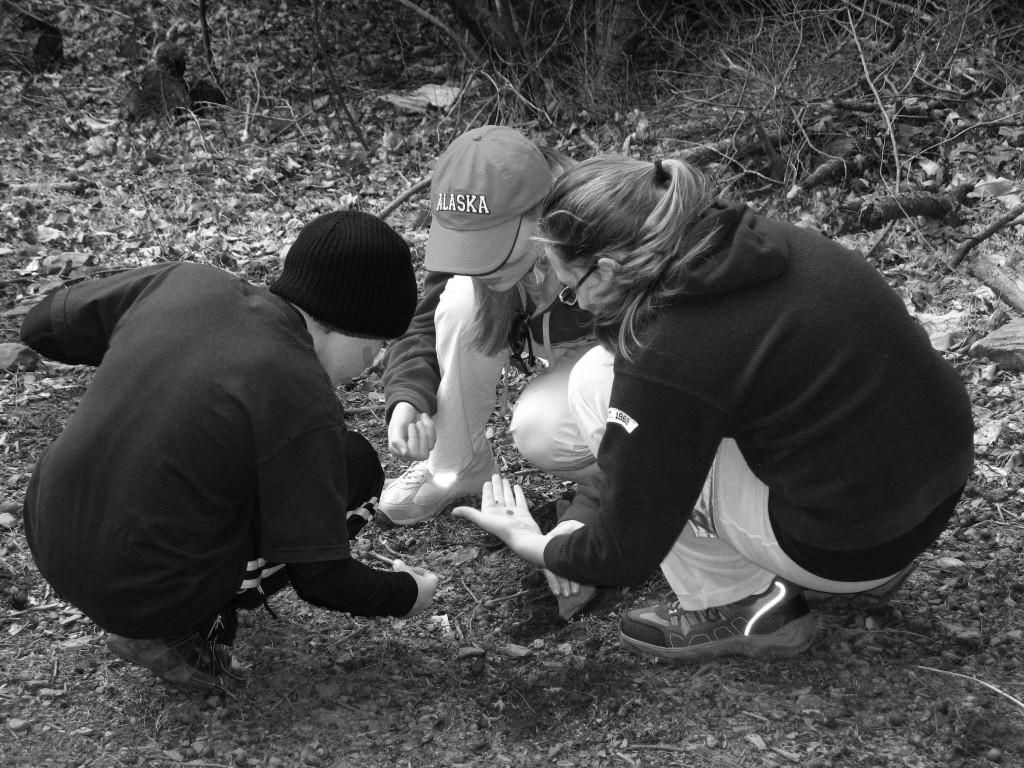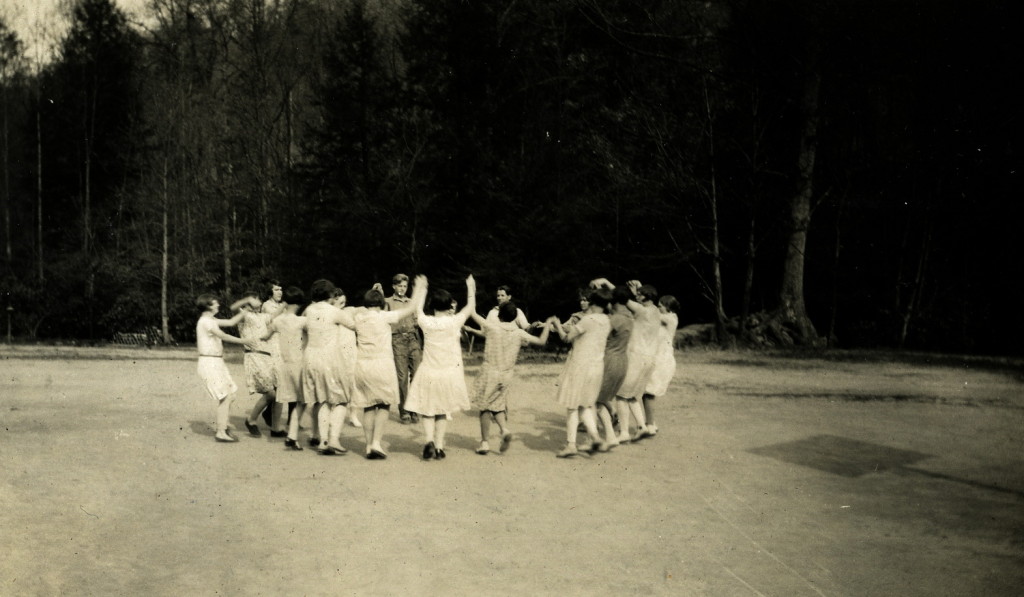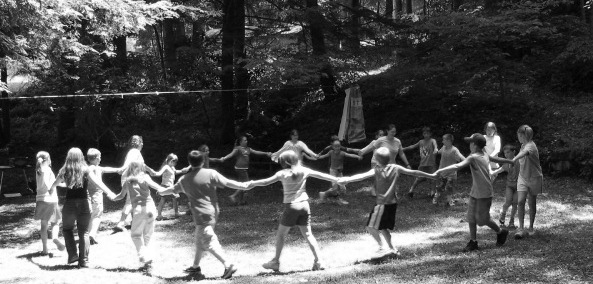Pine Mountain Settlement School
DANCING IN THE CABBAGE PATCH
BLOG
DANCING IN THE CABBAGE PATCH Coming Back and Going Some More
TAGS: Roscoe Giffin, Southern Mountaineer, Cincinnati, migration, report, Social Service Association of Greater Cincinnati, Mayor’s Friendly Relations Committee, workshop, Kentucky migration, sociological studies, statistics, population studies
ROSCOE GIFFIN AND THE 1954 CINCINNATI WORKSHOP
In April of 1954, Roscoe Giffin, faculty at Berea College, Kentucky attended an important workshop held in Cincinnati, Ohio, and convened by the Mayor’s Friendly Relations Committee [MFRC] and the Social Service Association [SSA] of Greater Cincinnati. The gathering was titled simply, “The Southern Mountaineer in Cincinnati.” The workshop was conceived as a means to review the growing complexity of social issues surrounding “the newcomers from the Kentucky’s hills.”
Dr. Giffin was asked to write the “The Southern Mountaineer in Cincinnati,” April 29, 1954, [the copy represented here is a second printing] that would bring together the issues facing the group and to assist in preparing the final report with the staff of the Mayor’s Friendly Relations Committee. Giffin’s work is a benchmark study of the going and sometimes coming back of Appalachian families who migrated to urban settings.
The issues for discussion determined by the participants were outlined as statements in the study:
- Substantial migration from the hills will go on due to the area’s poverty and high birthrate
- These migrants’ adjustment to city life, as workers, parents and citizens, is important to Cincinnati
- Too many now make a poor adjustment, to their own hurt and that of social agencies, city services, schools, churches, industry, and community relations generally
- The gap and conflict between living-ways of hills and city can be studied like any intergroup problem
- Pooling local experience and sociological data can reduce our ignorance and stereotypes, in fruitful consultation
A little over 200 individuals attended the workshop. With the support of the SSA [Social Service Association of Greater Cincinnati], and the MFRC [Mayor’s Friendly Relations Committee], and a host of social workers, educators, government officials, personnel directors, and church and civic leaders, the joined effort produced a report. “The Southern Mountaineer in Cincinnati,” April 29, 1954, [here, second printing]. The final report was compiled by the staff of the Mayor’s Friendly Relations Committee and Dr. Roscoe Giffin, of Berea College. It is a classic study of the going and coming back of Appalachian families to urban settings.
Dr. Giffin’s report is based on his observations of the work of the Cincinnati workshop and his own observations of the “culturally determined patterns of behavior which the Southern Mountaineers bring with them when they come to live north of the Ohio River.” By the necessity of the requirements of the urban setting, Dr. Giffin focused his report on “observed patterns of behavior” of the Southern Mountaineers in the urban setting and not on generalized behaviors associated with the people in their mountain regions. This declared bifurcation did not always work out in Dr. Giffin’s report, as it is near impossible to separate the two without assigning the Appalachian urban dweller a new identity. But, perhaps that is one of his points.
KENTUCKY MIGRATION
What is so very valuable in Giffin’s study is the substantive work that he brought to the gathering social crisis identified with the mass migration of Appalachians to northern industrial cities such as Cincinnati. Statistically, he paints a growing population shift after 1870 in Ohio from the migration of populations from three states: Pennsylvania, Kentucky, and West Virginia.
By 1910 Kentucky had the second-largest number of migrants in Ohio in the metropolitan area of Cincinnati. The largest population migration was to Pennsylvania, and West Virginia represented the third largest. By 1950 the entire Southern Appalachians were populated by approximately 8 million people. Also by 1950 the distribution was roughly the same, but the new Ohio (not just Cincinnati) immigrant numbers had increased dramatically
1950 MIGRANTS
| Pennsylvania | 309,000 (new residents living in Cincinnati) |
| Kentucky | 275,000 (new residents living in Cincinnati) |
| West Virginia | 103,000 (new residents living in Cincinnati) |
In the United States in 1950, Giffin informs us that there were some 3.5 million people who had been born in Kentucky but only 2.4 million were living there. This put 1.1 million people living somewhere else. This suggests that the out-migration rate was near 1 in every 3 persons born in the state of Kentucky who chose to live somewhere other than Kentucky. Giffin points to the recurring cycle of coal-related employment as the impetus for most migration. As coal began to decrease production following the end of World War II its market shares saw a sharp decline and the jobs related to coal quickly collapsed. The economic bottom drop out from under the poorly trained miners and those dependent on the coal economy. Out-migration saw upwards of 100,000 plus or minus people leave the state of Kentucky during the decline as coal began decreasing its production. The whip-lash boom and bust of coal production continued for decades following the downturn exhausting both people and industry.
What seems so striking about the migration of people from the Southern Appalachians is the mobility of the migrants as they experienced the rapid shifts. While their mobility was fluid, the population tended to unite in cultural clusters within the chosen destinations. The cultural cohesion in the new locations was and is not remarkable to Kentucky migrants. They migrated but they rarely severed their roots. Time and again Dr. Giffin notes the flow of cars filled with migrants going back to their states of origin for brief visits. When times get tough and the migration increases the flow expands but as economic conditions improve for the families the ebb tide brings them back to “home” and family. This brief but frequent return and immersion in their familiar surroundings, Giffin describes as a desire for the familiar, an integration that can be described as “knowing your way around” — a kind of immersion in family ties that reduces the emotional deficit” that strange places often bring about.”
THE PROCESS OF APPALACHIAN MIGRATION
Giffin describes the process of migration as a familiar set of actions. At “home” the migrants sit around their familiar tables, laden with the familiar comfort foods, and tell family stories and share stories of the new familiar city life. City life holds a considerable attraction for the young and a tense dynamic often begins to evolve in the nuclear family. Giffin suggests that the larger the family the stronger the pull for migrants to maintain a connection with their home area. This “familism is a force that repeats itself over and over again in large Appalachian families, both yesterday and today. It is of interest to Giffin that, as the Appalachian birth rate slowed starting in the 1950s to a 38/1000 ratio today, the pull to return “home” has not slowed significantly though the returning population is largely comprised of those of retirement age. Another shift noted by Giffin in the urban populations is that the birth rate among the migrant Appalachian families declined. The result was a lessening of the pressure placed on housing in the urban landscape. The housing demographic is of particular interest to Giffin.
He suggests that the quality of living in an urban environment while supporting a family of 7 to 8 children requires significant income. Food, which often came from family gardens is now no longer available in the city and must be purchased and on top of rent. The economic demands substantially reduced any gains in the family income. Housing in the city for transient populations is generally rental and often sub-standard as the urban landlords often exhibit hostile patterns of behavior toward the Appalachian populations and extortion is not uncommon.
The new economic demands, particularly the housing demands gave families some urgency to seek out and form strong community bonds with Appalachian neighbors and other migrants and ethnic minorities. Giffin points out that these bonds are necessarily strong bonds.
WOMEN
In the 1950s, however, the patterns of behavior in the Appalachian family were not so remarkable to only that demographic. Giffin seeks to describe them as a people apart, but the activity he assigns to their situation was repeated in many cities in the United States. It is a behavior that he called “well-marked.” He points us toward the women in the household. Women across the country, he reminds us, were not leaving the home to work he declares. Men still dominated the household wage-earner position women were still discouraged from leaving the home to work.
Women who did seek employment often faced the criticism of other women who saw work as interfering with child raising. Care for children and affordability of child care were strong deterrents to women desiring to work outside the home in the 1950s. It was a trend that was diminishing but could still be found in communities throughout the country. Giffin declares that the move to city life disrupted the cycle of “chores” that Appalachian family members engaged in. He observes, that the discipline that accompanied the cyclical work routines such as working the land and maintaining animals began to fall away in the city and new patterns began to develop.
Giffin observed that neighbors in the migrant communities of the city often changed frequently and long interpersonal relationships were hard to establish. “Knowing your neighbor” and relying on the neighbor in an emergency became significant issues for struggling families in the city. The desire for the “community” had driven the Appalachians into extended communities of relatives and regional clusters but even those could not sustain the pressures of urban life. The family authority also shifted to the mother, suggests Giffin, as the fathers were often more absent in the city environment. Giffin notes that this shift in parental control often resulted in the children’s and mothers’ anger issues toward the “absent but frustrated control needs” of the father.
WORK AND “JUST SETTIN” AND SCHOOL
Social issues surrounding motivation are also cited by Giffin. He declared that the rural behavior which he calls, “just settin’ showed a marked disinclination toward competition and did not prepare the transplanted migrant children to deal with the competitive rivalry of city living. This lack of competitive rivalry, he notes did little to prepare the children for success against the more competitive and versatile city dweller. Giffin tells us that “just settin'” is seen as “loafing” by the native city-dwellers and a growing bias began to be evident in the areas of work and school.
Schooling was also a significant flash-point in the dialogs of workshop participants. Giffin looked at the graduation statistics of the mountain counties of Kentucky and determined that less than 15% completed high school in 1950. In some counties, he studied he found that in the age group of adults over 45 most had less than 5 years of schooling. Absenteeism was a chronic problem in the mountains and he cited the observation of half to one-third of the 7 to 13-year-old children who were out of school! This low regard for education placed many of the children far below their peers when they relocated to the city. It is little wonder muses Giffin that absenteeism was a chronic problem with the migrating families. in their new home.
MILITARY SERVICE
Giffin’s figures for the military draft, seem to disagree with the popular notion that the Southern Appalachians saw a disproportionate number of men swept up in the draft. The general myth has persisted that the Appalachians go to war in disproportionate numbers, This appears to Giffin as incorrect. The picture of strong young and eager men going to war and showing unusual bravery, such as the classic Sgt. York film mythology was not born out in the statistics. Based on an article cited by Giffin authored by J.J. McGrath, “Selective Service Rejectees — a Challenge to Our Schools,” in School Life, Vol. 35, No. 2, Dec. 1952 (pp. 35-37), the Selective Service in 1952 rejected 1/3 to 1/2 of all young men called into service from the Southern Appalachian region. This statistical analysis places the Appalachian region’s states among the highest rejection rates in the nation in 1952. However, this does not take away from the high numbers from the region that served with honor and distinction in both WWI and WWII.
RELIGION
On the topic of religion, the Giffen study also has some surprising observations. He makes room for basically two strains of religious practice. The one, the Holiness organizations, he suggests are attached to social status and reflect the belief that members “…are the elect because anyone who is rich obviously didn’t get there on the basis of virtue.” This “virtuous” group of believers is contrasted with the second group of more mainline denominations. This group is seen to be more affluent and members of the Baptist or more fundamentalist traditions. He notes that both the Holiness adherents and the Baptists seem to ignore the social gospel and show little interest in associating their beliefs with a social consciousness or action. This rather harsh observation suggests to Giffin that religion played a negligible role in moving the migrants toward any organized social self-rehabilitation.
MONEY MANAGEMENT AND “The characteristic of the species ,,,”
Money management is another area that Giffin cites as problematic to some classes of Appalachian migrants in their new urban homes. A pattern that Giffin points to is the lack of ability to negotiate the thrift of tangible property and the saving of money. He notes an “easy come easy go” attitude to money earned by many Appalachians. He also suggests that there is another set of values, including thrift, that can be seen in some migrants. It is a tendency that Giffin suggests has its origins in the mountaineers’ Puritan heritage but then does not further explain. Giffin suggests that the Cincinnati social service folk will rarely see migrants who come to their offices seeking relief from their social problems. Giffin points to what he sees as a tendency for the migrants to see themselves as small numbers in a large city. As a group, they migrate in very small numbers to the city and only rarely will seek financial aid or present themselves as a perceived “problem case.”
At this point in the Giffin report, a phrase jumped off the page at this reader. It was his use of “the characteristic of the species ‘Southern Mountaineer’.” “Species”! Really? Up to this point, I could find points of identity with many of his observations, but suddenly I found myself lumped with a “species” that was separate from the rest of America. I began feeling like many migrants must have been made to feel in their new home. A “Rare species” suggests that any migrant from the Southern Appalachians is a rare species apart from the greater humanity — a sub-human being? The often-made comments about the Appalachian’s long and lanky arms, “slouching” figures, out-houses, and “Why do you talk different —look different?” surged to the top of my brain. Giffin, now seemed, to this reader, as the unsympathetic observer and not an advocate for the welfare of the migrant he first seemed to champion.
Through the lens of the twenty-first century and as a Central Appalachian Mountaineer [Southern Mountaineer], I suddenly found myself wanting to take issue with Giffin and his observations. I wanted to be sitting in his classroom at Berea debating what made a sociologist tribalize his subjects — and that class full of Appalachian students. Strange as this reaction may seem to some, it was associated with the very section of the Giffin study that dealt with the freedom to see things differently. In many ways, Giffin touched on a dilemma that still plagues migrants and immigrants throughout the world. How do we maintain our identity with dignity and not with our native defenses? On reading this section again it seemed valuable to transcribe a section in its entirety. Reading the quote again, I forgave him a little for his use of “species” which he isolated by quotes around “Southern Mountaineer”
“Free to Differ, But —: Continuing this listing of the characteristics of the species “Southern Mountaineer,” we must not overlook the behavioral patterns centered around individualism. They expect to have their own decisions accepted and grant to others the right to their own decisions and the right to differ. ‘…Mountain people are inclined to be nonconformists. Many … have … ability to go their own way … being quite sure that their own way is just as good as anyone else’s.'” (20)
The quote within the quote is that of Edwin E. White, who wrote Highland Heritage, published by Friendship Press, New York, (p.35), in 1947. It is often cited in connection with the perplexing problem of defining “culture” in Appalachia. In actuality, White’s book was written in 1937, not 1947. It was then re-published in 1947, ten years later, with no revisions. White, a Presbyterian minister, was not unlike William Aspenwell Bradley, whose article, “The Folk Culture in the Cumberlands,” in the Dial of 1918, tried to make a direct connection of Folk culture as found in Appalachia with the essence of American civilization. Even early writers as admired as John C. Campbell, in The Southern Highlander and His Homeland, used a broad brush to categorize mountain people…. it always ended badly as it set us apart — while yet giving us a “homeland” and consequently an identity.
The insistence on associating Appalachian mountain people with specific ethnic, even racial, folk, and, for goodness sake, “species,” has been a trend that has plagued the field of Appalachian studies for the length of its existence. Sometime after 1920 this need to isolate the exceptional in the native Appalachian dweller began to fray and today our contemporary conception of the nature of America’s civilization is one that is fundamentally comprised of both migrants and immigrants who share many of the same aspirations basic to well-being.
Another grave concern in the report of the Cincinnati workshop, in this writer’s view, is the omission of a full accounting of African-American Appalachians as integral to an understanding of Appalachians, generally. Irish? Italians? Or? To read the report is to assume that there were no African Americans making the journey to Cincinnati to find work and that the only interaction occurs with “natives” or so-described Anglo-Saxon whites. The African American, Irish, Italian, German, and other racial and ethnic populations are also represented as distinct sub-cultures but rarely are they isolated as a “migration” group from some American rural area. African Americans fleeing slavery and poverty in the South seem the most closely aligned to the Appalachian migrant.
“Other,” is used today to set people apart and it continues to be a divisive word for Appalachian residents identified with a so-called Anglo-Saxon origin. Pulled along as “other,” America’s sub-cultures and sub-groups make up smaller proportions of many regions populations, but none of us is exempt from some sub-culture. The ratio of the “other” migrants in the Cincinnati social complex and their social relationship in the urban community is still under construction and discussion. Clearly, these “other” populations were not been seen as integral to a discussion of the whole of the Appalachian migrants in the 1950s.
All this close analysis of Giffin left me wondering about the isolation of intervention. It left me wondering if a consideration all “others” would have come to fit Giffin’s analysis. Would those “others” have benefited from the targeted social services that aimed to care for the Appalachian migrants? What were the similarities? What were the differences? Who saw them as not “fitting” the social need? Would the “other” qualify as a “species” of Appalachian? Such is the nature of the continuing debate about what constitutes an Appalachian. Clearly, when “other” is used, or “species ” is defined, someone is disenfranchised. “Other” builds a wall around people. The term fragments the discussion of what should be universal empathy for the distress of all populations forced to migrate and to immigrate. Social intervention needs to be a human instinct for all people in distress, both here and abroad. Intervention can not be parsed out to species, but only to people. Recognition and empathy for the individual seem to still be out of the reach of our contemporary world which is now even more fractured than in the 1950s ….. and just what is “maximum recognition”? Empathy does not to be re-packaged.
MAXIMUM RECOGNITION
The author’s report continues its discussion of “Free to Differ, But …” and Giffin says
A practical application of these observations might be that personnel policies need to provide maximum recognition for the individual if their work is to yield mutual satisfaction.
I believe that this individualism shows up also as a tolerance which partly explains the fact that they possess less of the deep-seated racial and religious prejudices characteristic of many Americans, both North and South. I am of the opinion that in the right atmosphere, they will lose their prejudices rather quickly. Such prejudice as they have is more like a coat than a suit of underwear into which one has been sewed. At Berea, we have found that their socially inherited prejudices yield quite readily to the medication of the integrated living of diverse racial, ethnic, and religious groups.
Migration is a story of going and coming back, but today’s migration is also a story of the struggle to identify a place that welcomes and understands going and coming back. We now have a world in a state of migration and immigration as people seek to leave places where life has become intolerable. Today people are on the move due to many reasons: economic pressures, civil strife, political oppression, war, disease, and drought. ocean rise, environmental disasters, and a myriad of other impingements on quality of life.
MIND YOUR OWN BUSINESS
But, with an eye to the growing tensions in contemporary life, all these dilemmas bring us to another characteristic found in Giffin’s study. That is, “Mind Your Own Business.” While most scholars acknowledge the general individualism and tolerance of the Appalachian people, there is a long history of feuds among Appalachian people that could quickly escalate and result in violence. Such anger can also be slow to dissolve, says Giffin in his analysis. Guns still play a role in solving grudges, family disputes, and perceived injustices. With the prevalence of guns in society today and the long-standing role of guns in Appalachian households, this tendency is and should be a point of major concern to urban and rural social service providers, alike. I suspect Giffin would find many who are sympathetic to this view.
WORDS ARE DIFFERENT
Well, I knew it was coming. Our language. Words Are Different, says Giffin — when spoken by an Appalachian. He notes that the language of Appalachian folk is distinctive. There is no disputing this auditory evidence, Scholars and others have found the distinctive sound and pattern and choice of words in the language of many Appalachians to be a treasure and a wealth of creative expression. Others have found the language of Appalachians to be “Hillbilly English” and a way to single “those people” out from the mainstream of American life and to label them as “ignorant”, uncultured, and lacking in social skill, particularly the skills of social dialog. It is my view and that of Giffin that what is needed is not a re-tooling of Appalachian English but a lesson in listening to the general population. We all need to listen — not just to the unique cadence and construction of the language found among Appalachian people, but also to what is being said. We could all benefit from a conversation that doesn’t focus on the “accent” before listening to the message.
SUMMARY
In summary, Dr. Giffin leaves us with this message. Listen and Look and get Beyond the Data. He questions whether we can statistically isolate the average Southern Mountaineer and notes that his survey is preliminary and partial.
He provided the conference attendees a list of his summarized innate characteristics of Appalachian migrants
| Behavior is directed by the traditions of the culture, but marked individualism is an aspect of this tradition. | |
| At home in the mountains, the stranger is received usually with cordial hospitality which may be concealed beneath certain shyness and reticence of manner. | |
| Placidity of manner and behavior yields readily to any word or action which infringes on the prevailing definition of the rights of a free independent, self-reliant individual. | |
| When so provoked, the response is apt to be militant if not violent. | |
| Persons of authority tend to be defined as threatening rather than helping symbols though accredited authority is usually paid its due. |
Throughout this report by Dr. Giffin I kept thinking of my grandfather in a migrant culture in some city in the North. I wondered how he fared. I thought about the process of describing the Appalachian migrant and defining his needs against what I knew and did not know about my grandfather. I thought about my own absorption of Appalachian traditions and culture and my own long “migration” path that turned me into an “outsider” of my geography.
I recollected my own goings and comings and the patterns and traditions that I thought were unique and that held resonance with the patterns seen in the Giffin report. I thought about the current political tribalism that so readily identifies those for “us” and against “us”. I mused about the current state of the nation and measured that against the turmoil I have seen characterized in the political attention paid to Appalachia and Appalachians. I have learned that “going back” is sometimes painful, and sometimes joyful. I have learned to question my “Appalachianess” and to treasure it and distance myself from it when it centers on the darker side of human nature.
What is lost and what is gained from all the coming and going from our places of origin? What does it mean to have an identity? Are we born with identity? Is it enough just to be a part of humanity in this world of branding? Our labels used to be on the inside. We had style, not fashion, or the even more sinister, fad. As Appalachian born have we been co-opted? Will the current identity crisis only be a fad defined by the J.D. Vances of the world? Our problem is not in the symbol but in the semiotics.
In giving this coming and going a deep thought, I remembered what I read in a favorite book by Raymond Williams, The Country and the City, as he watched his rural countryside being destroyed by manufacturing and railroads.
“It is not the known, but the knowable community: A selected society in a selected point of view.”
I did not go and come back. I am constantly going and coming back and going and selecting my point of view.
SEE:

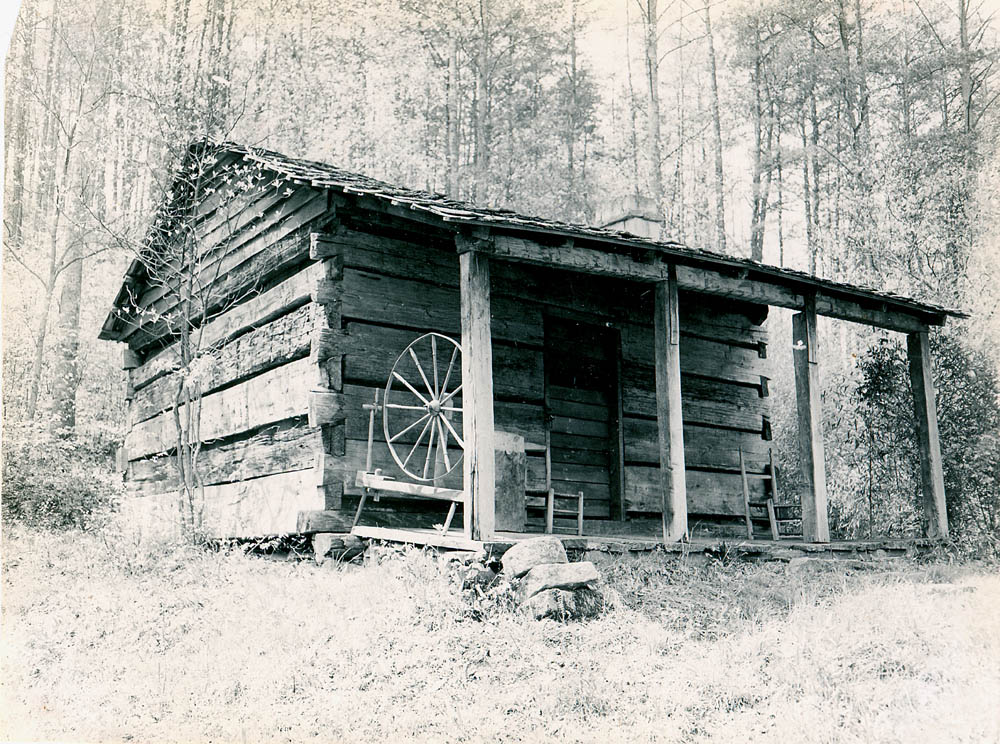 Aunt Sal’s Cabin at Pine Mountain Settlement School
Aunt Sal’s Cabin at Pine Mountain Settlement School
